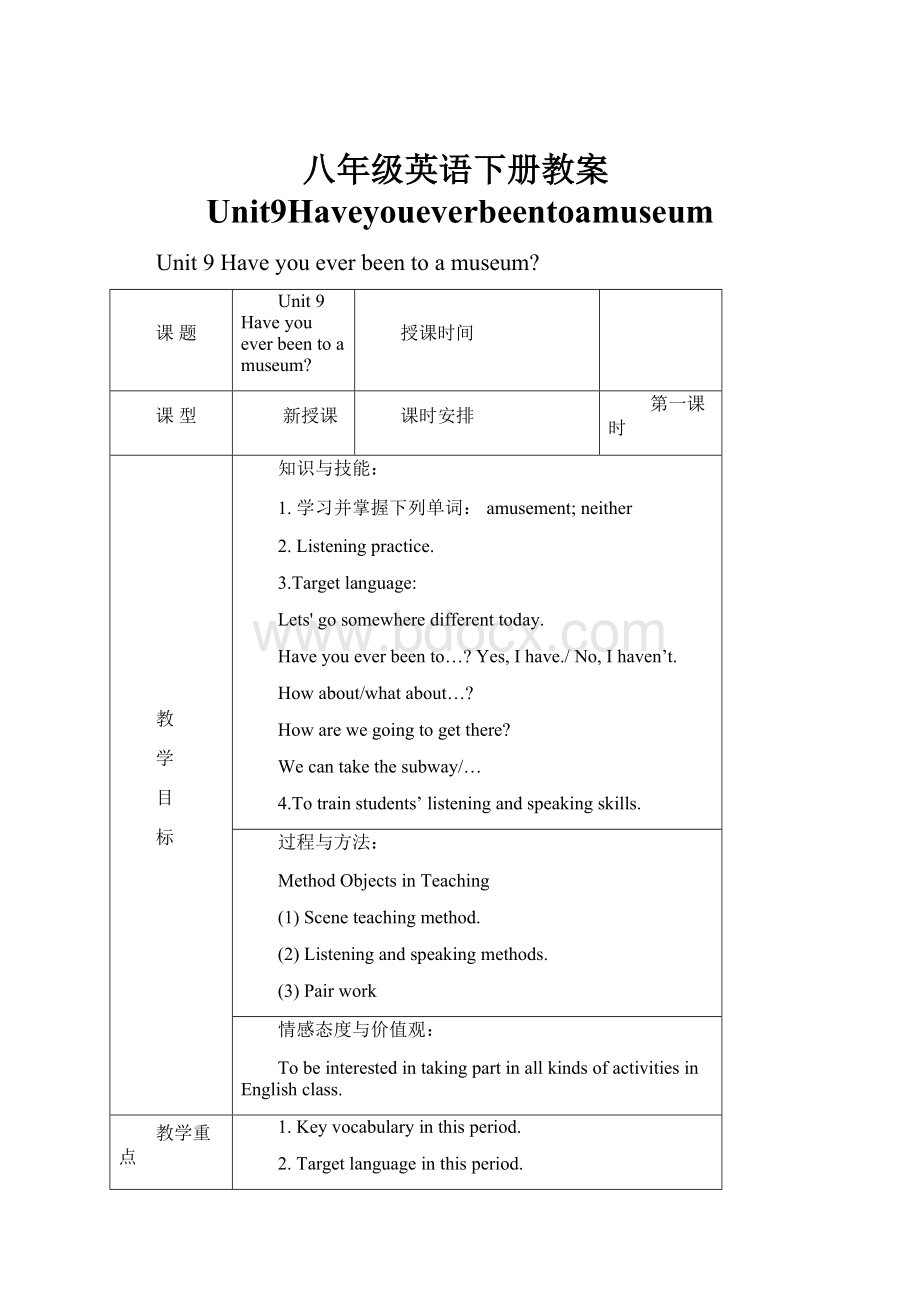八年级英语下册教案Unit9Haveyoueverbeentoamuseum.docx
《八年级英语下册教案Unit9Haveyoueverbeentoamuseum.docx》由会员分享,可在线阅读,更多相关《八年级英语下册教案Unit9Haveyoueverbeentoamuseum.docx(19页珍藏版)》请在冰豆网上搜索。

八年级英语下册教案Unit9Haveyoueverbeentoamuseum
Unit9Haveyoueverbeentoamuseum?
课题
Unit9Haveyoueverbeentoamuseum?
授课时间
课型
新授课
课时安排
第一课时
教
学
目
标
知识与技能:
1.学习并掌握下列单词:
amusement;neither
2.Listeningpractice.
3.Targetlanguage:
Lets'gosomewheredifferenttoday.
Haveyoueverbeento…?
Yes,Ihave./No,Ihaven’t.
Howabout/whatabout…?
Howarewegoingtogetthere?
Wecantakethesubway/…
4.Totrainstudents’listeningandspeakingskills.
过程与方法:
MethodObjectsinTeaching
(1)Sceneteachingmethod.
(2)Listeningandspeakingmethods.
(3)Pairwork
情感态度与价值观:
TobeinterestedintakingpartinallkindsofactivitiesinEnglishclass.
教学重点
1.Keyvocabularyinthisperiod.
2.Targetlanguageinthisperiod.
教学难点
2.TeachingDifficulty
Makeconversationsfreelyusingthetargetlanguage.
教具学具准备
Ataperecorder,CAI
教学方法
情景教学和合作学习法
教学过程
导入新课:
Step1GreetingsandRevision
Greettheclassandcheckthehomework.
Step2Lead-in
Guesstheplacesofthepictures;theyaretheBritishMuseum,spacemuseum,historymuseum,waterpark,zoo,amusementparkwhileleadinsentencepatterns:
“Haveyoueverbeento…?
”
Getstudentstoworkinpairstopracticetheconversation:
“Haveyoueverbeento…”
“Yes,Ihave”/Not,Ihaven’t.
二、教学新课
Step3Pre-listening
1.SectionA1a
T:
OK.NowopenyourbooksonPage65.InPart1a,6placesaregiven.Pleasereadthenamesoftheseplaces.(Teacherwritesthenamesontheblackboard.)Whichoftheseplaceswouldyouliketovisit?
Rankthemfrom1to5.
S4:
Amusementpark_____,waterpark_____,zoo_____aquarium_____spacemuseum_____.
S5:
Spacemuseum_____,aquarium_____,zoo_____,waterpark____,amusementpark_____
S6:
…
2.Talkaboutthepicture
Step4Listening
Listenandchoosethebestanswer.Thefirstandthesecondquestionaimtolisteningtotime,andthethirdoneaimstolistenfortherelationship.Thisactivitytrainsstudents’listeningabilityforlisteningforspecificrelationship.
1)WhendidSarahvisittheNationalScienceMuseum?
A.TodayB.YesterdayC.Lastyear
2)WhendidClaudiavisitthenaturemuseum?
lastyearB.lastsummerC.Lastschooltrip
3)Whatmaytherelationshipbebetweenthetwospeakers?
A.FriendsB.Teacherandstudent
C.Motherandkid.
Answer:
CCA
Step5Speaking
Askandanswerinpairs:
A:
let’sgosomewheredifferenttoday.
B:
OK.Wheredoyouwanttogo?
A:
Haveyoueverbeentothespacemuseum?
B:
No,Ihaven’t.Howaboutyou?
A:
…
Step6Listening2a2b
Listenandcircletheplacesthatyouhear.
ListenagainandcircleTfortrueorFforfalse.
三、课堂练习:
Step6Exercise
1.我去过北京两次。
I_________________Beijingtwice.
2.大声读书是一种学习英语的好方法。
Readingaloud______________tolearnEnglish.
3.昨天他没有去那,我也没去。
Hedidn’tgothereyesterday.______________.
4.我了解了一些电影的知识。
I____________someinformationaboutmovie.
5.他的粗心导致了这次失败。
Hiscarelessness__________thisfailure.
选用have,has填空:
1.I_______toldhimthenews.
2.She________comebackfromschool.
3.You________wonthegame.
五、布置作业:
1.Practicethedialogueandrememberthelanguagepoints.
2.Previewthenextlesson.
六、板书设计:
Unit9Haveyoueverbeentoamuseum?
Lets'gosomewheredifferenttoday.
Haveyoueverbeento…?
Yes,Ihave./No,Ihaven’t.
Howabout/whatabout…?
Howarewegoingtogetthere?
Wecantakethesubway/…
七、教学后记
复备
复备
Unit9Haveyoueverbeentoamuseum?
课题
Unit9Haveyoueverbeentoamuseum?
授课时间
课型
新授课
课时安排
第二课时
教
学
目
标
知识与技能:
1.学习并掌握下列单词:
unbelievable,progress,rapid,unusual,toilet,encourage,social,peaceful,performance,perfect,itself,collect
2.Targetlanguage:
1)Iwonderhowmuchmorecomputerwillbeabletodointhefuture
2)Watchingthempreparetheteawiththebeautifulteasetsisjustasenjoyableasdrinkingtheteaitself
3.Totrainstudents’readingability
4.Togetstudentsknowsomeknowledgeaboutmanykindsofmuseums.
过程与方法:
MethodObjectsinTeaching
1)Skimmingfordetails.
2)Readingforcomprehension.
3)Communicativeapproach.
情感态度与价值观:
Toraisestudents’interestoflearningEnglish.
教学重点
Keyvocabulary:
unbelievable,progress,rapid,unusual,toilet,encourage,social,peaceful,performance,perfect,itself,collect
教学难点
1)Howtoimprovereadingskill.
2)Tounderstandthepassageandtheculture.
教具学具准备
Ataperecorder,CAI
教学方法
情景教学和合作学习法
教学过程
导入新课:
Step1GreetingsandRevision
Lookatthepicturesandmakeconversation:
A:
Haveyoueverbeento…?
B:
Yes,Ihave./No,Ihaven’t.
二、教学新课
Step2Pre-reading
Brainstorm:
thinkofthekindsofmuseumsthatyoucanname.
Watchavideo.AvideoabouttheInternationalMuseumofToilets
Talkaboutthevideo.
Step3Fastreading
Matchthewordswithitsmeaningandlearnsomenewwords.
TrueorFalse
()1.AmericanComputerMuseumonlyhasinformationaboutdifferentcomputersthere.
()2.Kenthinkscomputerswilldomoreworkinthefuture.
()3.InternationalMuseumofToiletsisaveryunusualmuseum.
()4.Indiahasthemostadvancedtoilet.
()5.Linlindidn’tknowwhyhergrandpaloveddrinkingandcollectingteaset.
Step4Detailedreading
Readthepassageagainandanswerthequestions.
Whichthreemuseumsdothestudentstalkabout?
WhatdoesKensayabouttheAmericanComputerMuseum?
3.WhatcanwelearnattheInternationalMuseumofToilets?
4.WhyistheHangzhouNationalTeaMuseumaniceplacetoenjoytea?
5.Whatdoyouthinkisthemostinterestingthingabouteachmuseum?
Step5Explanation
1.ThemostinterestingmuseumI’vebeentoistheAmericanComputerMuseum.
多音节词和部分双音节形容词最高级加most构成,前面加the。
如:
themostbeautifulgirl
2.Theoldcomputersweremuchbigger.
much可修饰形容词比较级,表示……得多。
如:
muchricher
alittle,even,abit也可以修饰形容词比较级。
三、课堂练习:
按要求改写下列各句:
4.Theyhaveboughtacomputer.(改成否定句)___________________________________
5.Hehaslosthisbook.(改一般疑问句,肯定与否定回答)
______________________________________________________________________
Step6Exercise
Exercise
1.我去过北京两次。
I_________________Beijingtwice.
2.大声读书是一种学习英语的好方法。
Readingaloud______________tolearnEnglish.
3.昨天他没有去那,我也没去。
Hedidn’tgothereyesterday.______________.
4.我了解了一些电影的知识。
I____________someinformationaboutmovie.
5.他的粗心导致了这次失败。
Hiscarelessness__________thisfailure.
选用have,has填空:
1.I_______toldhimthenews.
2.She________comebackfromschool.
3.You________wonthegame.
四、课堂小结:
五、布置作业:
1.Rememberthewordsandexpressions.
2.Finishtheexercisesintheworkbook.
六、板书设计:
Unit9Haveyoueverbeentoamuseum?
1)Iwonderhowmuchmorecomputerwillbeabletodointhefuture
2)Watchingthempreparetheteawiththebeautifulteasetsisjustasenjoyableasdrinkingtheteaitself
七、教学后记
复备
复备
Unit9Haveyoueverbeentoamuseum?
课题
Unit9Haveyoueverbeentoamuseum?
授课时间
课型
新授课
课时安排
第三课时
教
学
目
标
知识与技能:
1.1)Targetlanguage:
Haveyoueverbeentoasciencemuseum?
Yes,I’vebeentoasciencemuseum./
No,I’veneverbeentoasciencemuseum.
Haveyouevervisitedthespacemuseum?
Yes,Ihave.Iwenttherelastyear./
No,Ihaven’t.
I’vebeentotheartmuseummanytimes.
Me,too.AndI’vealsovisitedthenaturemuseum.
过程与方法:
(1)Explanationmethod.
(2)Exercisemethods.
情感态度与价值观:
Toraisestudents’interestoflearningEnglish.
教学重点
1.Thepresentperfecttense.
2.Howtousethepresentperfecttense.
教学难点
Tounderstandandusethepresentperfecttense.
教具学具准备
Ataperecorder,CAI
教学方法
情景教学和合作学习法
教学过程
导入新课:
Step1GreetingsandRevision
Greettheclassasusualandcheckthehomework.
AskstudentstoreadthesentencesofGrammarfocusaloud.
二、教学新课
Step2LearnthePresentPerfectTense
1.用法
肯定式
否定式
I/You/We/Theyhavefinishedthework.
He/She/Ithasfinishedthework.
I/You/We/Theyhavenotfinishedthe
work.
He/She/Ithasnotfinishedthework.
构成:
have(助动词)+p.p
has(第三人称单数助动词)+p.p
疑问式
回答
HaveI/youfinishedthework?
Hashe/shefinishedthework?
Yes,you/Ihave.
No,you/Ihaven’t.
Yes,he/shehas.
No,he/shehasn’t.
havenot常缩略为haven’t
hasnot常缩略为hasn’t
2.havebeento&havegoneto区别
比较:
HehasbeentoBeijing.他曾去过北京。
(人已回来,可能在这儿)
HehasgonetoBeijing.他已经去北京了。
(人已走,不在这儿了)。
have/hasbeen(to)表示“曾经到过某地”,说话时此人不在那里,已经回来。
侧重指经历。
have/hasgone(to)表示某人“已经去某地了”,说话时此人可能在路上或已到那里,反正不在这里。
3.一般过去时与现在完成时的区别
比较:
Ihaveseenthefilm..我看过这部电影。
(我了解这部电影的内容)
Isawthefilmlastmonth.我上个月看了这部电影。
(只说明上星期看了这部电影,不涉及现在情况)
一般过去时只强调过去的动作;现在完成时强调过去的事情对现在的影响。
一般过去时通常与表示过去的时间状语连用;现在完成时则不能与表示过去的时间状语连用。
一般过去时单纯表示过去的经历;现在完成时表示过去的动作或状态延续到现在并可能持续下去。
一般过去时的时间状语有:
yesterday,lastweek,…ago,in1980,inOctober,justnow…
共同的时间状语有:
thismorning,tonight,thissummer,before,already,…
现在完成时的时间状语有:
for,since,ever,never,just,already,yet,inpastyears,…
三、课堂练习:
I.根据括号内的要求完成下列各句,每空一词(含缩写)。
1.Myparentshavecomebackalready.(改为否定句)
Myparents_____________back____.
2.TheboyshavebeentoJapanlotsoftimes.(改为一般疑问句)
_______theboys_______toJapanlotsoftimes?
3.Hasyoursistergonetothebookstore?
(作肯定回答)
_______,she_______.
四、课堂小结:
Inthisclass,we’vereviewthepresentperfecttense.Thenwehavedonesomeexerciseswithclass.
五、布置作业:
1.Rememberthewordsandexpressions.
2.Finishtheexercisesintheworkbook.
六、板书设计:
Unit9Haveyoueverbeentoamuseum?
Haveyouevervisitedthespacemuseum?
Yes,Ihave.Iwenttherelastyear./
No,Ihaven’t.
I’vebeentotheartmuseummanytimes.
Me,too.AndI’vealsovisitedthenaturemuseum.
七、教学后记
复备
复备
复备
Unit9Haveyoueverbeentoamuseum?
课题
Unit9Haveyoueverbeentoamuseum?
授课时